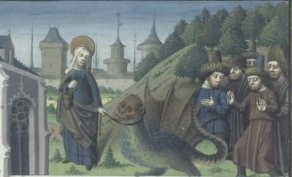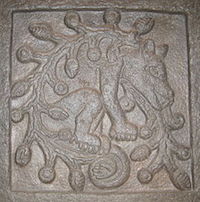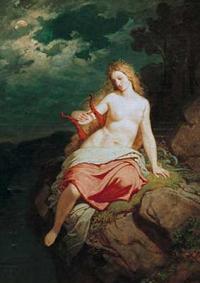Bestiary |
Tarasque

It was 25th November 2005 when one supernatural being was introduced to a list of Masterpieces of the Oral and Intangible Heritage of Humanity by UNESCO. Well it wasn’t exactly that one being and the date that was written in November was actually last Sunday of June, however I will forget these details for a while, so we can get through this much faster.
Tarasque, as the name may suggest, is of French origin. If French is known for some mythological creatures, it would be dragons. Tarasque is one of them. Six bear legs, body of a bull with turtle shell, lion’s head and scaly tail with scorpion stinger on its tip. Place of origin: Galatia. Parents: Leviathan and Onachus. Losses: eaten cattle and servants, severely damaged knights. Exterminator: Saint Martha. Town that bears this dragon’s name: Tarascon.
The aforementioned event is called La fete de la Tarasque and it has been happening since year 1469, when King of Naples, Count of Provence, et cetera, duke René d’Anjou made two processions in honour of Saint Martha. One took place on aforementioned Sunday, the other one on 29th June. He wanted this to happen every year since, however after few seasons it faded away. Later it was restored and continued every year until it became part of cultural heritage.
It presents a story that happened near town of Tarascon, long ago in times when Provence was pagan and often visited by missionaries of new religion.
Dragon that lived at the shore of the river Rhone used to eat everything that appeared in his proximity, including cattle and people. One day sixteen courageous men, fully armoured, embark on killing the dragon.
Eight of them returned, eight of them were eaten by a dragon. These results were enough to force Martha, currently residing in Tarascon, to counteract. She went to the dragon’s lair and faced it alone. After sprinkling it with holy water she tied a ribbon around its neck and led it out from its lair like one would lead a dog. Sudden bravery of locals helped them to stone the dragon and accept baptism.
This story was a basis for aforementioned processions. In first there eight men walking in a model of a dragon and another eight men who are walking alongside them. The focal point of the second procession is a young woman in white that leads a dragon on a ribbon.
Illustration by unknown middle-age artist [Public domain], via Wikimedia Commons
5.12.2017 (25.11.2012)
Bysen
This creature is haunting the Swedish island of Gotland. Similar to other forest spirits, it also likes to trick people. Mostly lumberjacks. He appears as a small green man or a stump. Sometimes (not when he looks like a stump) he wears a red cap and an axe. Bysars (plural of Bysen) are of common European folklore origin. Most of the time they are spirits of people who were pushing boundary stones. Other times they are just common thieves, destined to wander aimlessly through forests for an eternity. The first group of Bysar can be freed from their curse by putting the boundary stones in the right places; the others have to chop down the forests of Gotland. They however work very slowly, about two or three trees each century, thus they fall short of modern technology.
11.12.2017 (1.1.2010)
Grýla
The story is the same everywhere – witches eat bad-behaving children. Iceland isn’t an exception. In its hills lives monstrous giantess Grýla, which commonly searches for food in nearby valleys. In the past she was active for an entire year, paying no attention to the weather nor what date it was. Now she’s forced to focus only on Christmas. She’s working together with thirteen men, for whom she became like a mother. (In the eighteenth century it was illegal to use Grýla to scare children.) The aforementioned men are considered her children, and why not, if her Russian counterpart, Baba Yaga, could have a son who was a dragon. Grýla, however, had children even before she adopted these thirteen “Christmasers”, daughter Sóla for example. Many stories assigned her as many as three husbands; it’s said that the last one was named Leppalúði.
24.12.2017 (13.5.2012)
Jólasveinarnir
Christmas men. Thirteen figures of Icelandic folklore. Their count used to change similarly to their customs. Some of them only used to poke fun at people, and others ate children. Stories are different depending on the region. Crucial for these men, sons of the infamous Grýla, was the beginning of the twentieth century. Santa Claus invaded the entire world and from continental Scandinavia came Julenisser, Christmas elves. They were much kinder than their Icelandic cousins. Combining these two (Julenisser and Jólasveinarnir) was very beneficial for Jólasveinarnir. They still had their names, and their parents were still Grýla and Leppalúði, however, their reputation was better. This led to them ending up handing over Christmas presents. They wore a red uniform, Santa Claus style. At first, they brought only common Icelandic clothes or rags, as is common with boggarts.
They used to make mischief, but now they bring presents, thirteen days before Christmas, each one on his own day. They also stay for thirteen days, so Stekkjastaur, who arrives on the 12th of December, leaves on the twenty-fifth, while his brother Kertasnikir serves from the twenty-fourth of December to the sixth of January. We now know the names of two of them so let’s look at the others, their order, and what they used to do.
Stekkjastaur was teasing sheep.
Giljagaur was invading stables and stealing milk.
Stúfur was eating stolen pies and left only their crust.
Þvörusleikir was licking spoons.
Pottaskefill was eating leftovers.
Askasleikir was hiding under the bed, waiting for someone to leave plates with food there.
Hurðaskellir was slamming doors at night.
Skyrgámur was eating skyr (Icelandic yogurt).
Bjúgnakrækir was stealing sausages from a chimney.
Gluggagægir was looking through windows to see what he could steal.
Gáttaþefur was using his big nose to sniff a local Christmas pie called laufabrauð.
Ketkrókur was using a hook to steal meat.
Kertasníkir was stealing candles (then made from tallow, thus edible).
24.12.2017 (22.12.2012)
Sinterklaas
The being that hands over presents in the Netherlands was actually the origin of Santa Claus. Unlike Santa Claus, Sinterklaas is active on his name day, the 5th of December. He arrives in November on a white horse from the sea. His assistant is Black Peter (Zwarte Piet). Like his more known successor, Sinterklaas is based on Nicolas of Smyrna, the bishop that took care of abandoned children. His name was created by combining Sint Nikolaas (Saint Nicolas). There is another one in the Netherlands, Kerstmann, however isn’t as popular as Sinterklas.
24.12.2017 (21.12. 2003)
Silverpilen
One of the Swedish ghosts is a very unusual creature. It takes a very modern form, that of a train. Well... it’s not that unusual. Since the creation of railroads, people have been telling stories about ghostly trains.
Silver bullet was an underground train of C5 type, that wasn’t painted so it had its aluminum color. It really existed – as an experimental (and later backup) train. It even showed itself in movies. Many people, however, didn’t believe that it was really, mainly because it was very rare for it to show itself in Stockholm’s underground and because people like stories and legends about a train suddenly appearing in closed tunnels was born. It’s said that whoever enters it, wouldn’t see the light of day once again. Stockholm’s underground is very big and even has one station that was never opened (Kymlinge), so it is easy to imagine that being like this would be there like home.
24.12.2017 (25.7.2011)
Luduan
Luduan (sometimes jueduan) is a deer-like creature with green fur, a horse tail, and a horn on its head. It’s another in a long line of Chinese unicorns. It brings luck, talks in every language, and is so fast that it can travel nine thousand kilometers in one day. Luduan once even met Genghis Khan himself, and it is said that thanks to this encounter, this conqueror hasn’t attacked India.
30.1.2018 (2.7.2017)
Blackeman, Grissell and Greedigut
Grissell and Greedigut were two demons that served Joana Wallis of Keyston, known in the past as Huntingtonshire, now Cambridgeshire. They took form of two black dogs. That was nearly as apparent as if there was a black cat on her shoulder and a flying broom in her shed. Or if she could cure a cold. This story took place in 1646 at the time of witch-hunts.
Her little helpers brought her two or three shillings per week. According to Elizabeth Weed, another witch of the same coven, Grissell and Greedigut were two little pups, one white, the other black. She also talked about a demon named or nicknamed Blackeman, who gave her these pets and in exchange possessed her body three times per week.
30.1.2018 (19.11.2012)
Camelopardalus
Even old Romans didn’t pay much attention to newly found animals. Building the Roman empire was more important and thus came to be a creature that you can see today – not in Zoos or African steppes – but on coats of arms. Half camel, half leopard. It was the first, albeit a little shoddy, attempt to describe animals of the Giraffidae family – giraffes.
“How does this animal look? Well, I can’t draw, but try to imagine a camel with leopard’s skin.”
Camelopardalus was haunted up to the middle-ages until it was eternalized by Carl Linnaeus, who used this name while making a scientific name for a real giraffe – Giraffa camelopardalis.
Thanks to the heraldry, many mythical creatures managed to survive. Among them are two related ones. Allocamelus is a combination of a camel and a donkey and cameolpardalus is very similar to camelopardalus, however, it has two little curved horns.
30.1.2018 (14.12.2001)
Tokway
Tokway is a forest ghost from the Trobriand Islands, near New Guinea. Aboriginal people there must make peace with the Tokway every time they want to chop down a tree used to make a canoe. There is a complex ritual that they use. First of all, the tree must be cut a little and food has to be inserted into the hole in the tree. The ritual continues with long incantations where the Tokway is praised and carpentry work is cursed.
30.1.2018 (18.4.2004)
Írusán
King of the cats who lived in the Knowth cave, a burial chamber that lies two miles away from more known Newgrange. He looks like a cat, but you wouldn’t mistake it for any ordinary pet, thanks to his bull-like size. He steals people… but more like fairies. To understand this, I can recommend you Tolkien’s essay On-Fairy Stories.
Despite being a supernatural creature, even Írusán met his end. One day he caught bard Senchán Torpéist, who mocked cats in one of his songs, and ran with him on his back until he was hit by a heated-up rake thrown by saint Ciarán near Clonmacnoise.
7.2.2018 (22.10.2006)
Kerrhprrh
In times past, the forests were green as far as an eye can see. And then civilization came … and … no, this is another fairy-tale. Or more precisely, reality, that concerned Indians of the Ona tribe, living in Tierra del Fuego. Fifty years ago there were about fifty of them, now, nobody survived, only their memoirs. And creatures, for example, a parrot named Kerrhprrh. His role was turning green leaves red when autumn came. According to the legend that J. Cambell wrote down, it took place long ago, when women of the Ona tribe were witches and majestic mountains that we can see today, were people.
27.2.2018 (16.2.2003)
Ahuizotl

Let’s set things straight, the real Ahuizotl was more dangerous than his mythical namesake. This was the name of the Aztec ruler (1486 – 1502), who, among other common hobbies of dictators – conquering –, was a fan of sacrificing his people, even seventy-two thousand in four days. Mesoamerican religions loved blood, read the book Popol Vuh.
Original Ahuizotl, the creature used as a symbol of the aforementioned ruler, was a water monster that looked like: a) a dog with a long tail with a human hand on its end, or b) half human, half ape, or eventually c) hybrid of a dog and snake.
That is the fate of every mythical creature; their appearance changes over time. In any case, Ahuizotl had a human hand on its tail. This was its most distinctive attribute.
Ahuizotl was mimicking crying for help and when a savior showed himself and jumped into the lake (water creatures are most commonly associated with fresh water, even in maritime countries), its hand pulled him into the water. Other times it was swimming in the lake and attacking fishermen.
It ate human meat, however, its favorites were teeth, nails, and eyes. Without these body parts were its victims usually found three days later. It’s said that their souls went straight to Paradise.
Illustration by Infrogmation, New Orleans (Photo by Infrogmation) [Public domain], via Wikimedia Commons
14.3.2018 (30. 7. 2001)
Lorelei

Lorelei sits on a cliff overlooking the Rhine; she sings and lures sailors to their demise. Most known German fairie is attractive for more than one reason. If we skip the obvious – her singing and her alluring visage – we can focus on more obscure details:
1) To be proper, Lorelei is the geological object standing more than one hundred meters tall, not the lady sitting on it. This is the same as with the case of the Flying Dutchman: when an inanimate object has anthropomorphic addition, the story is slowly focusing more on that. Living or at least wanna-be-living creatures are closer to the human mind. Even planes at the time of World Wars had to be spoilt by Gremlins.
The aforementioned cliff plays role in another story – the treasure of the Nibelungs is hidden underneath, according to the latest heroic (so non-mythological) version of the legend. This obvious orientation spot grabbed people’s attention, like for example Czech mountains Blaník or Říp.
2) Thanks to the acoustical conditions of the cliff (special echo), it is the ideal spot for sirens. River under also helps thanks to its fast flow and multitudes of rocks in it. If Lorelei were not to be a singing fairy, she could be … well, this couldn’t happen, because…
3) The maiden sitting above the river isn’t the fairy her whole life, as one could suspect. She once was nothing but a normal mortal woman. Nothing is out of the ordinary in similar stories, sometimes simple people can have interesting careers. Glaukos and Heracles in Greece. Or some of the Scandinavian gods to mention at least some. Most of the times there are supposed to haunt or act in similar manner, mainly if they got this position in a way like Lorelei – worrying over tragic love, that ended with her jumping in the waters of Rhine. Overall common story, there is, however, another important part.
4) Although the legend of Lorelei has every attribute of a basic folklore story with pagan origins, it is quite possible that everything comes from the pen of Clemense Brentan, a friend of the Grimm brothers and another collector of folklore. Lorelei first appeared in the poem Zu Bacharach am Rheine from the book Godwi (1802). It knows that the story itself was however popularised later by Heinrich Heine.
5) Age of the long-haired woman on the cliff is inconsistent, to say the least. Sometimes this serves to connect Lorelei to a similar myth at that time. For example, the motive of a girl combing her long hair – a lot of similar beings do so. In German folklore, this is connected to Holda, who sits on the cliff over the river Mohan. Despite the similarities, she does not drown people, everyone who sees her, however, loses his sight and mind.
Illustration by Philipp Foltz [Public domain], via Wikimedia Commons
4.4.2018 (12.6.2012)
Nāḥāš
The best way to introduce today’s guest is this citation:
“Now the serpent was craftier than any other beast of the field that the Lord God had made. He said to the woman, “Did God actually say, ‘You shall not eat of any tree in the garden’?” (Gen 3,1)
It is the snake of paradise.
The word Nāḥāš is a Hebrew name for this kind of reptile, nothing more. It seems, that the only thing that is different here than amongst others of the Serpentes suborder, is its ability to speak and think. It doesn’t look that, at least in the biblical version, it is the embodiment of Satan. The story about this snake’s confrontation with God is basically just an animal fable:
So the Lord God said to the serpent, “Because you have done this,
“Cursed are you above all livestock
and all wild animals!
You will crawl on your belly
and you will eat dust
all the days of your life.”
(Gen 3,14)
Theologists however think otherwise and this creature, which was one of the two (Balaam’s donkey being the second) animals that spoke a human language in the Bible, is accused of bestowing its body to Satan.
On the other hand, we can think, that the Nāḥāš of paradise had to look quite different before its punishment.
10.4.2018 (13.3.2016)
Zburătorul
He enters the dreams of Romanian women looking like attractive young man, however normally this incubus looks like a winged fire dragon.
10.4.2018 (19.3.2017)
Abatwa
Somewhere on the southern end of Africa lives a miniature nation. And miniature it is indeed – its people are so small they can (and also do) sleep in anthills. They succeed from the tall grass, where they are unseen. After the successful hunt, they set camp near the prey’s body and do not leave until it is gone, and then they move to find another by riding on a horse (sitting in a line, one behind the other, from the ear to the tail).
Despite the fact that these little people show themselves only to children, magicians, and pregnant women in the seventh month (and only if their child would be a male), they can also bother other kinds of human beings. They would not let people sleep, waking them up by beating on their chest.
10.4.2018 (19.2.2017)
Wade and Bell
A long time ago, a giant named Wade and his wife Bell lived in Northern Yorkshire, where Whitby lies today. They were not evil like others of their kind in British folklore, maybe the reason was that they were part of an ancient nation that lived in times when living together with non-human forms was common and without inconveniences.
A lot of buildings in the surroundings of Whitby, that are still standing today are making of this pair. Stone circles, castles Pickering and Mulgrave, the road through the swamps that Wade made so Bell can reach their giant cow better. Some of that was later accredited to Romans, however, there is proof – in the castle Mulgrave there was a giant rib of one of them. That cannot be argued with. Sadly, it was the only whale's jaw.
10.4.2018 (5.12.2004)
Zardan

As were said many times before, legends, stories, and both official and unofficial demonologic literature knows a lot of devils by their names, however, these are usually prominent ones, bosses of different hell resorts, and so on. Common devils do not have this kind of accolade. When you deal with demons, you usually have more important questions than asking them what their name is. When you meet one by coincidence, you rather think about how to escape.
One of the more famous of them is Zardan, the devil which is mentioned in French literature, but you can find his traces in Prague. Particularly in Vyšehrad, where while walking in a park, you can see the pillar broken into three pieces.
It is the memento of the bet that Zardan made with Saint Peter. When Vyšehrad’s church was being built, Saint Peter was the one who oversaw its construction. The devil was supplying him with stone. He was getting bored, so his devilish nature awoken and he made a bet with Saint Peter. The devil said, that he will be able to bring to Vyšehrad the pillar from the cathedral of Saint Peter in Rome. And he will make it before the mass is over.
Peter accepted the bet, but was uncertain about it, he knew that Zardan is not particularly slow, nor weak. The saint tried to slow the devil down multiple times.
Three times in Venice, he pushed him into the sea, however, the devil was not afraid. He had a lot of cargo, so he needed to rest for a while. We can still see his traces today, in Southern Bohemia, in Novosedly nad Nežárkou. He finally arrived in Prague, but too late. Filled with anger, he threw the pillar on the nearby rock, breaking the pillar in the process. And the pieces of it are still on Vyšehrad and so does Zardan’s name.
Photo (full size) by Petr Vyhlidka, [CC BY 4.0].
5.5.2018 (25.12.2005)
Jimaninos
Every god needs some helpers, let alone the one that spins the Wheel of the Year. Little people called jimaninos lived alongside Aztecs in present-day Mexico and it was them, who had this job. A little bit of linguistics: jimaninos are male, female counterparts are called jimaninas, these words mean “little children”.
This describes their appearance – jimaninos are winged, chubby, and unruly creatures, who usually avoid people. However, that is not the case while celebrating the holiday El Dia de Muerte on 2nd November. They dance in the streets, make mischief and visit cemeteries.
This may all make some sense – there is speculation that jimaninos are the souls of children, that died from an unknown disease.
24.5.2018 (9.2.2003)
Churn Milk Peg and Melch Dick
Elves from British folklore. They are guarding unharvested nuts against children. If a young raider feels a sudden stinging feeling, he has been warned. They stab people who prefer calm days sitting instead of working, too. They are not that active and diligent themselves, however, they do not like laziness. It is not hard to escape Peg and Dick and just simply lie down on the grass a few steps away.
24.5.2018 (18.9.2016)